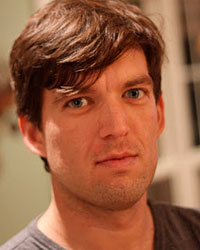2012 Janet Taylor Spence Award
Greg Hajcak
Stony Brook University
 What is the focus of your award-winning research?
What is the focus of your award-winning research?
A large portion of the work in my lab is basic in nature and utilizes psychophysiological measures to understand emotion, cognition, and their interaction. We are interested in how people process motivationally salient events and stimuli (e.g., making errors compared to correct responses; winning compared to losing money; viewing pleasant and unpleasant pictures compared to neutral pictures). Although we primarily use event-related brain potentials, or ERPs, we also employ the startle reflex, heart rate, skin conductance, pupillometry, eye tracking, and functional magnetic resonance imagining. As a clinical psychophysiologist, I am interested in psychopathology — how individual differences in anxiety, depression, and psychosis can be understood using specific neural activity and psychophysiological measures of affective-cognitive processes. Most recently, my work aims to move beyond neural correlates of psychopathology to identify biomarkers of risk. In addition, a growing amount of my work is developmental in nature and focuses on trajectories of emotion-cognition interactions as well as risk for psychopathology.
How did you develop an interest in this area?
Since college, I have been interested in the interplay between function and dysfunction — in particular, the possibility that understanding how the brain works can be leveraged to understand psychological disorders, and vice versa. In graduate school, I began with the error-related negativity (ERN) — a very early and reliable neural measure of error detection. We started studying the ERN and its relation to anxiety disorders, and over the past decade have come to appreciate the link between cognitive and motivational processes that might be reflected in the ERN. In a separate line of work, we wondered how the ERP response to emotional pictures was impacted by cognitive manipulations (i.e., emotion regulation) and individual differences in anxiety and depression. And more recently, we have been studying reward-related neural activity and how it relates to depression and risk for depression. In each case, my interest really comes from the possibility of using a very specific neural measure to understand both normal and abnormal psychological processes.
Who are your mentors and/or biggest psychological influences?
I went to graduate school at the University of Delaware, where I received a great deal of guidance, support, and tolerance from the faculty — they collectively helped me find my way and develop as an academic. I’m continually grateful for my graduate mentor and biggest psychological influence, Bob Simons. The work that comes from Peter Lang and Margaret Bradley’s lab continues to shape the way I think about emotion and psychopathology. I am indebted to Edna Foa and her group at the University of Pennsylvania for training me to think about, and treat, anxiety disorders. Finally, Dan Klein at Stony Brook University has been kind enough to provide continued, and invaluable, mentorship.
What unique factors have contributed to your early success?
I’d like to believe that being curious, excited, creative, careful, and hardworking have something to do with success in psychological science. But in many ways, I feel like the only thing I’ve ever really done is to capitalize on the opportunities before me. I had a great mentor in graduate school. I attended and became involved in the Society for Psychophysiological Research — and members of this society (too many to name) have been incredibly supportive over the years. I now have exceptional graduate students, collaborators, and colleagues. I owe everything to my academic family.
What does winning this award mean to you both personally and professionally?
To use reinforcement-learning language, this is certainly better than I expected. It is a wonderful distinction to receive the Janet Taylor Spence Award. If I used the term “transformative” to describe my own research, I’d hope that someone would evaluate me for mania. So the title of this award is absolutely humbling, and it is a real honor to be among the impressive group of past and present recipients. It is also a pleasure to be recognized by an organization that represents such a large and diverse group of excellent psychological scientists. I have been particularly excited about what APS continues to do for psychological and clinical science, so winning this award from APS, in particular, is gravy.

